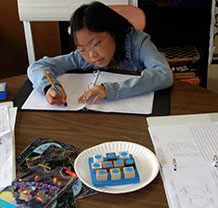How can we sort cubes that are all the same size?
4. Make meaning
Purpose of the discussion
The purpose of the discussion is to elicit students’ ideas about what might explain the observation that the same-sized cubes of different materials have different weights. The discussion probes their ideas about the property we call “heavy-for-size,” a precursor to the concept of density.
The aim is for students to hear each other’s initial ideas — not to come to a “right” answer. As they conduct more investigations in the 4th and 5th grade Inquiry curricula, they will revisit the question.
Revisit the list of properties used to sort

Restate the investigation question:
Remind students that all the cubes are the same size and shape but are made of different materials. Explain that one property people used to sort the cubes was of weight (e.g., light, medium, heavy) and weight is going to be the focus of the discussion.
Engage students in the focus question
These cubes are all the same size and shape but have different weights: What do you think are some possible explanations?
Some ideas you might hear are:
- The cubes are made of different materials and the materials have different weights.
- The material in metals is packed more tightly than material in wood or plastics.
- Each piece of copper weighs more than a piece of wood the same size.
- There's more air in the wood - it doesn't look all solid.
- The light cubes are hollow and the heavy ones filled with heavy things.
Supporting questions
Note: Students commonly think wood or plastic cubes are light because they are hollow inside. While sometimes objects are hollow or filled with other materials, it is not true in this case. Explain that each cube is made of just one material and is solid all the way through.
Can you think how you might test the idea that some cubes are hollow and some are filled with other things?
- Cut the cubes in half.
What do you think the copper cube looks like on the inside?
- It looks the same all the way through.
- It has other things (heavy) things inside.
Show students the aluminum and pine cubes that are cut in half.
Recap the discussion
Explain that the goal of this discussion was to hear people’s ideas about why — when the materials cubes are all the same size — some materials weigh more or less than others. Summarize ideas you have heard. Point out the evidence that ruled out the idea that the light cubes could be hollow and the heavy ones filled with heavy materials. Explain that we won’t try to answer the question now but it’s something to continue to think about. Wrap up with the message that materials have properties such as color, luster, and a property called “heavy for size,” that is, some materials are heavier for the size of the sample than others. A copper cube and a pine cube are the same size but the copper is heavier for the size than pine.



